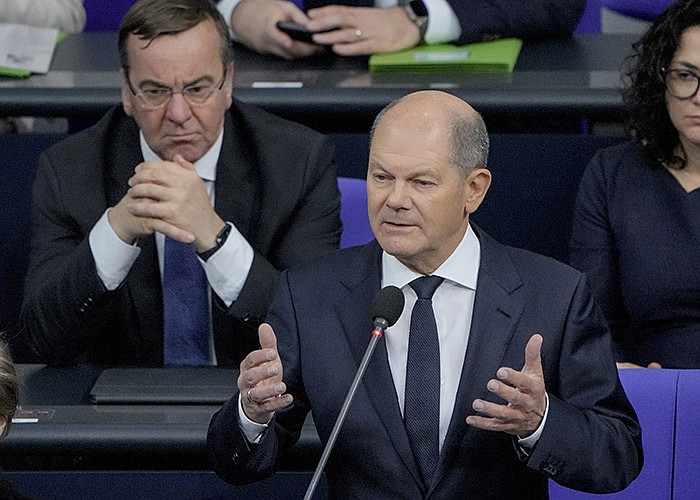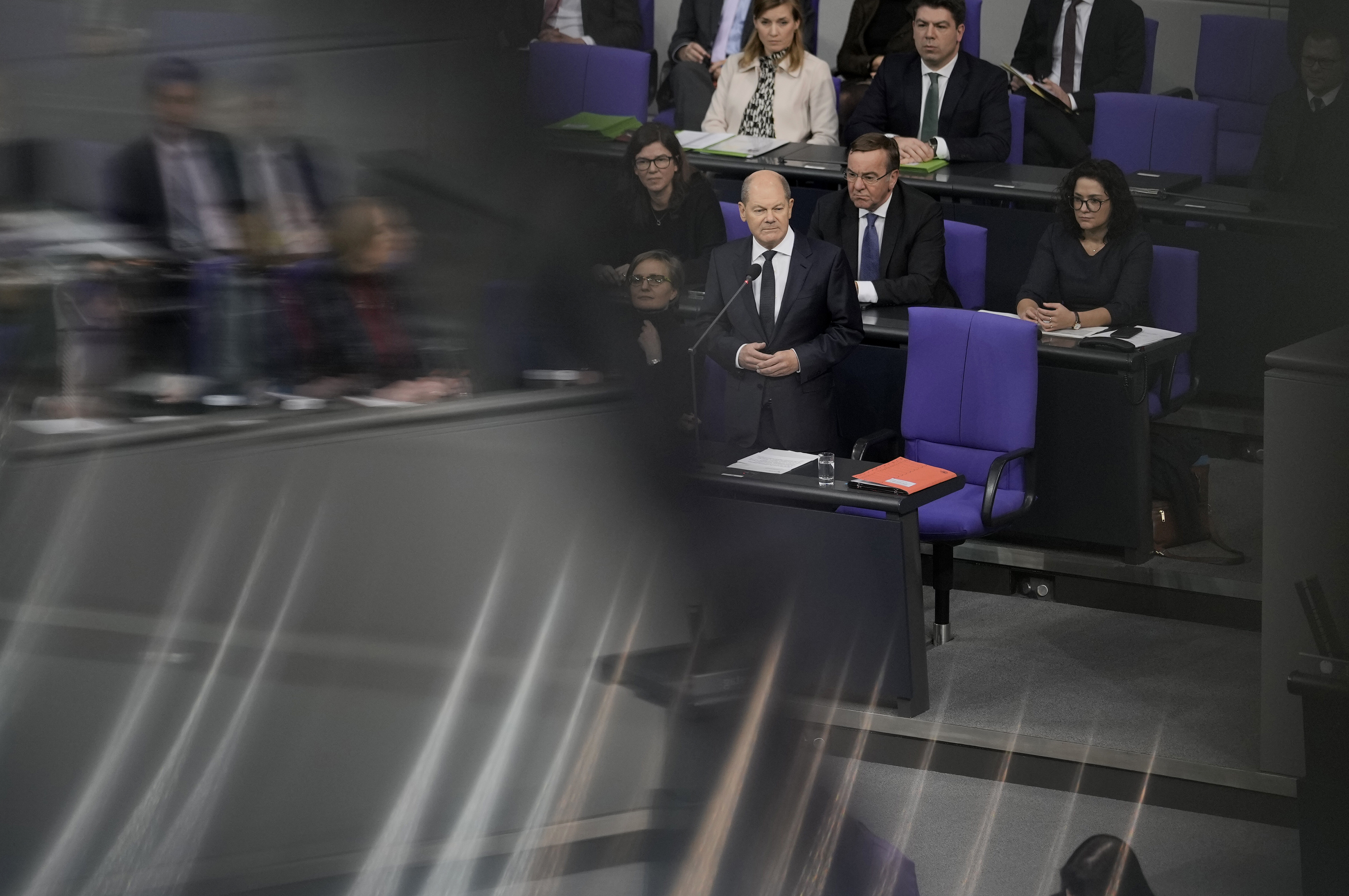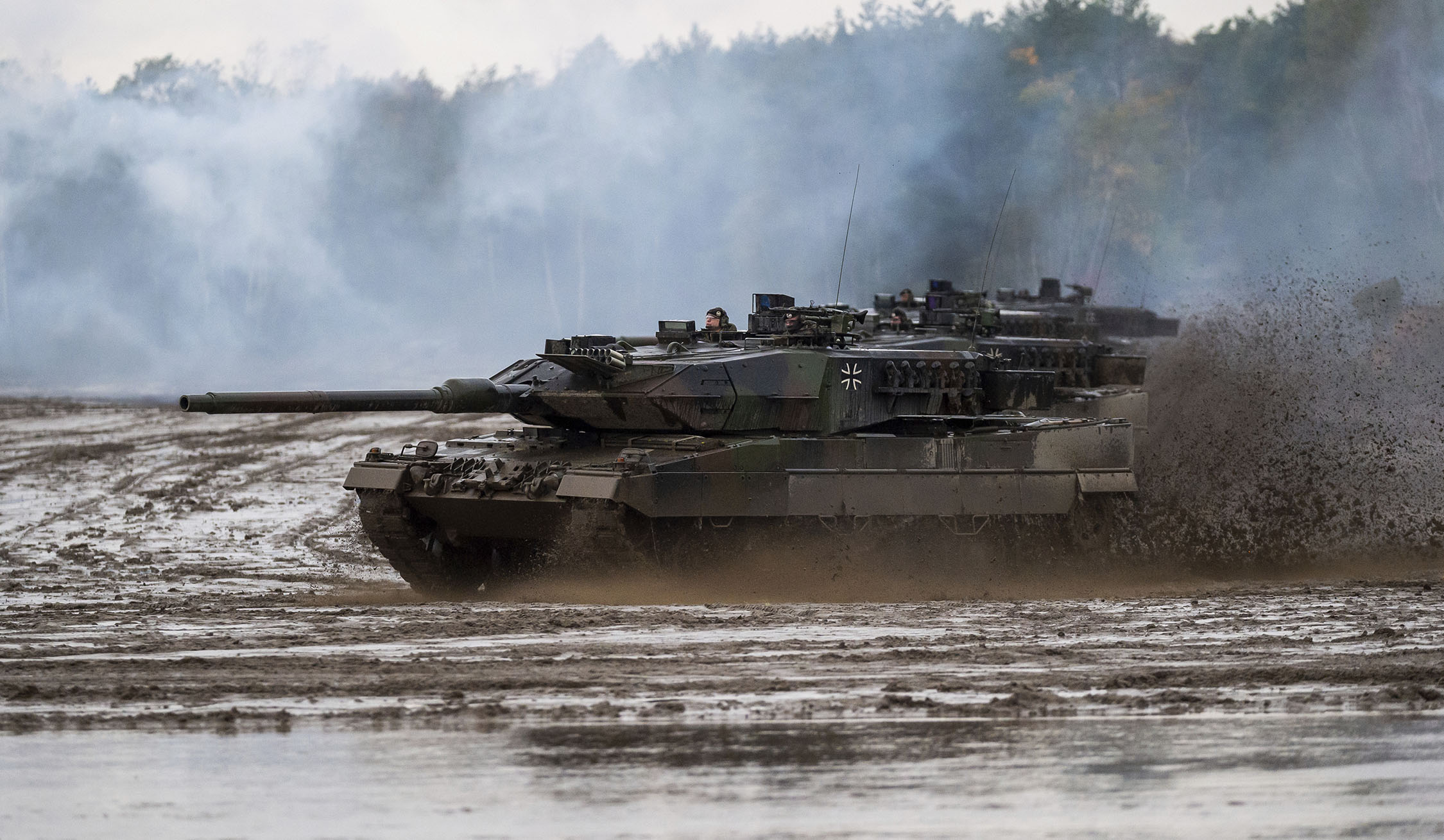BERLIN -- Germany and the United States announced Wednesday that they will send advanced battle tanks to Ukraine, offering what one expert called an "armored punching force" to help Kyiv break combat stalemates as the Russian invasion enters its 12th month.
The announcement marked the first stage of a coordinated effort by the West to provide dozens of the heavy weapons, which Ukrainian military commanders said would enable counter-offensives, reduce casualties and help restore dwindling ammunition supplies.
American President Joe Biden said the U.S. will send 31 M1 Abrams tanks, reversing months of persistent arguments by Washington that they were too difficult for Ukrainian troops to operate and maintain.
The U.S. decision followed Germany's agreement to send 14 Leopard 2 A6 tanks from its own stocks. Germany had refused to send the Leopards unless the U.S. put its Abrams on the table, not wanting to incur Russia's wrath without the U.S. making a similar commitment.
"This is the result of intensive consultations, once again, with our allies and international partners," Chancellor Olaf Scholz told German lawmakers. "It was right, and it is important that we didn't let ourselves be driven" into the decision.
Biden said European allies have agreed to send enough tanks to equip two Ukrainian tank battalions, or a total of 62 tanks.
"To liberate their land, they need to be able to counter Russia's evolving tactics and strategy on the battlefield in the very near term," Biden said.
Several European countries have equipped their armies with Leopard 2 tanks, and Germany's announcement means they can give some of their stocks to Ukraine.
Speaking in a video address late Wednesday, Ukrainian President Volodymyr Zelenskyy hailed the creation of what he described as a "tank coalition."
"We must form a tank fist, a fist of freedom whose hits will not let tyranny stand up again," Zelenskyy said.
He said Ukraine will push for more weapons, including long-range missiles and aircraft.
"The terrorist state must lose. The right to life must be protected. And it will be so," Zelenskyy said.
Though it will take months before the tanks arrive, Ukrainian soldiers on the front lines said the decision comes at a critical point.
"Tanks will help reduce casualties among our soldiers ... then gain new results and win this war quicker," said Oleksander Syrotiuk, commander of a company in the 17th Tank Brigade deployed in Bakhmut.
Ukrainian soldiers and experts said Ukrainian forces are running low on spare parts to repair old Soviet-era tanks and the specific ammunition they require while enduring relentless barrages of Russian artillery. The Western tanks could help open a new pipeline for ammunition to flow to Ukraine.
With an expected springtime Russian offensive looming, the tanks will also enable Ukraine's forces to launch new offensives and curb casualties, three military commanders, including two in the army's tank division, told The Associated Press.
"Without the new tanks, we cannot win this war," said Maksim Butolin, chief sergeant of the 54th Brigade's Tank Division. He spoke to the AP by phone earlier this week from near the Bakhmut front.
Ukrainian forces have had to preserve ammunition and deal with frequent breakdowns and maintenance issues, Syrotiuk said.
"The main problem we have with our tanks is they are old," he said.
Expressing a preference for the Leopard 2, which he said was more suitable for Ukraine's terrain, Syrotiuk said the modern tanks had more precise targeting systems, better armor and equipment to allow nighttime operations.
Gian Gentile, a U.S. Army veteran and senior historian with the Rand think tank, said the M1 Abrams and the Leopards will give Ukraine a "mechanized armored punching force."
The Abrams tanks can hit a moving target up to 1.25 miles away while rolling across rough terrain, he said.
INCHING CLOSER TO CONFLICT
While it is unclear whether the tanks will make a decisive difference in the spring offensive that Zelenskyy is now planning to take back territory seized by Russia, it is the latest in a series of gradual escalations that has inched the United States and its NATO allies closer to direct conflict with Russia.
In interviews, European and U.S. officials acknowledged that three months ago, it would have been inconceivable that Biden, Scholz and leaders of other European nations would have contributed such heavy arms. But over time, they argued, the battlefield has changed and they believed the threat that Russian President Vladimir Putin would reach for a tactical nuclear weapon to eviscerate Ukrainian forces has diminished.
Moreover, they said, they wanted to demonstrate to Putin that his bet that European unity would fracture over the winter had failed, and that NATO remained committed to the war even in the face of gas and oil cutoffs and fears that Russian cyberattacks would cripple European infrastructure.
"Putin expected Europe and the United States to weaken our resolve," Biden said at the White House, flanked by Secretary of State Antony Blinken and Defense Secretary Lloyd Austin. He added, "These tanks are further evidence of our enduring, unflagging commitment to Ukraine and our confidence in the skill of Ukrainian forces."
Only last week, Austin dismissed the idea of sending the Abrams tank, with his aides saying its long tail of supply and repair vehicles was too complex for the stretched Ukrainian forces to operate.
The No. 3 official in the Pentagon, Colin Kahl, said last week that "the Abrams tank is a very complicated piece of equipment," adding, "We should not be providing the Ukrainians systems they can't repair, they can't sustain, and that they, over the long term, can't afford, because it's not helpful."
But by promising Abrams tanks -- which John Kirby, the National Security Council spokesperson, said would take "many months" to be built by General Dynamics -- Biden was able to give Scholz political cover to send Leopard tanks by early spring. And Germany's decision opened the way for Spain, Poland and Finland to do the same, with Norway likely next to announce a similar contribution.
But Biden was clearly sensitive to the suggestion that he had been forced into the decision by one of his closest allies. He cast the issue as one of preserving unity. "We wanted to make sure we were all together," Biden said.
Scholz spoke by phone Wednesday with Biden, French President Emmanuel Macron, British Prime Minister Rishi Sunak and Italian Premier Giorgia Meloni, the German chancellery said in a statement. All five leaders agreed to continue military support to Ukraine in close Euro-Atlantic coordination.
Altogether, France, the U.K., the U.S., Poland, Germany, the Netherlands and Sweden will send hundreds of tanks and heavy armored vehicles to fortify Ukraine as it attempts to break through entrenched Russian lines.
'DISASTROUS PLAN,' RUSSIA SAYS
Ukraine's supporters have supplied tanks in the past, but those were Soviet models in the stockpiles of countries that once were in Moscow's sphere of influence but are now aligned with the West. Zelenskyy and other Ukrainian officials insisted their forces need more modern Western-designed tanks.
Russia's ambassador to Germany, Sergey Nechayev, called Berlin's decision "extremely dangerous," saying it "shifts the conflict to a new level of confrontation and contradicts the statements of German politicians about their reluctance to get involved in it."
Scholz had insisted that any decision to provide Ukraine with the powerful tanks would need to be taken in conjunction with Germany's allies, chiefly the U.S. By getting Washington to commit some of its own tanks, Berlin hopes to share the risk of any backlash from Russia.
Ekkehard Brose, head of the German military's Federal Academy for Security Policy, noted the deeper historical significance of the decision.
"German-made tanks will face off against Russian tanks in Ukraine once more," he said, adding that this was "not an easy thought" for Germany, which takes seriously its responsibility for the horrors of World War II.
"And yet it is the right decision," Brose said, arguing that it was up to Western democracies to help Ukraine stop Russia's military campaign.
German Defense Minister Boris Pistorius cautioned that it would take about three months for the first tanks to be deployed in Ukraine. He described the Leopard 2 as "the best battle tank in the world."
The German government said it planned to swiftly begin training Ukrainian tank crews in Germany. The package being put together would also include logistics, ammunition and maintenance.
Kremlin spokesman Dmitry Peskov said the tanks would "burn down."
"Simply because of technological aspects, this is a rather disastrous plan," Peskov said, citing "a completely obvious overestimation of the potential" the tanks would add to the Ukrainian military. "It is yet another fallacy, a rather profound one."
Peskov predicted that the tanks "will burn down just like all the other ones. ... Except they cost a lot, and this will fall on the shoulders of European taxpayers."
John Herbst, who was U.S. ambassador to Ukraine from 2003 to 2006, questioned the timeline for delivery of the American tanks.
"Under this schedule, Ukraine would be lucky to receive them this calendar year," said Herbst, who is now senior director of the Atlantic Council's Eurasia Center.
The U.S. tanks will be purchased through the Ukraine Security Assistance Initiative, which means it will take some time for the Ukrainian forces to receive the tanks and be able to deploy them on the battlefield. The Pentagon plans soon to begin training Ukrainian forces on the system outside of Ukraine.
The U.S. has thousands of Abrams in stock. Still, it does not have "excess stock," said Kirby. He said Ukraine's military will have to go through significant preparation to learn to operate, maintain and sustain the Abrams. It's a process that will take some months.
Using the assistance initiative funding route, instead of dipping into the existing U.S. stockpile, means it is unlikely the tanks will be available to Ukraine before Russia's anticipated spring offensive.
Kirby declined to pinpoint when the Abrams will be delivered, but said the German-made Leopards are expected to make their way to Ukrainian forces more quickly. The deployment also suggests that the U.S., and allies, are girding to support Ukraine for a long war that shows no signs of coming to an end.
Doug Bush, assistant secretary of the Army for acquisition, said the U.S. stock includes both the older variants and newer M1A2 Abrams variants, and when a "new" tank is needed, it starts with an older hull.
"We don't produce any tanks from scratch anymore," Bush said. "We have a large stock of older M1s that we use as seed vehicles. Were we to ever run out of those, sure we would build new. But right now, no matter which option we go, we don't have to build completely new."
Other European nations, such as Finland and Spain, indicated a willingness Wednesday to part with their own Leopard or similar battle tanks as part of a larger coalition.
Information for this article was contributed by Frank Jordans, Kirsten Grieshaber, Samya Kullab, Lolita C. Baldor, Matthew Lee, Nathan Ellgren, Vanessa Gera, Jill Lawless, Tara Copp and Aamer Madhaniof The Associated Press and by David E. Sanger, Eric Schmitt and Helene Cooper of The New York Times.
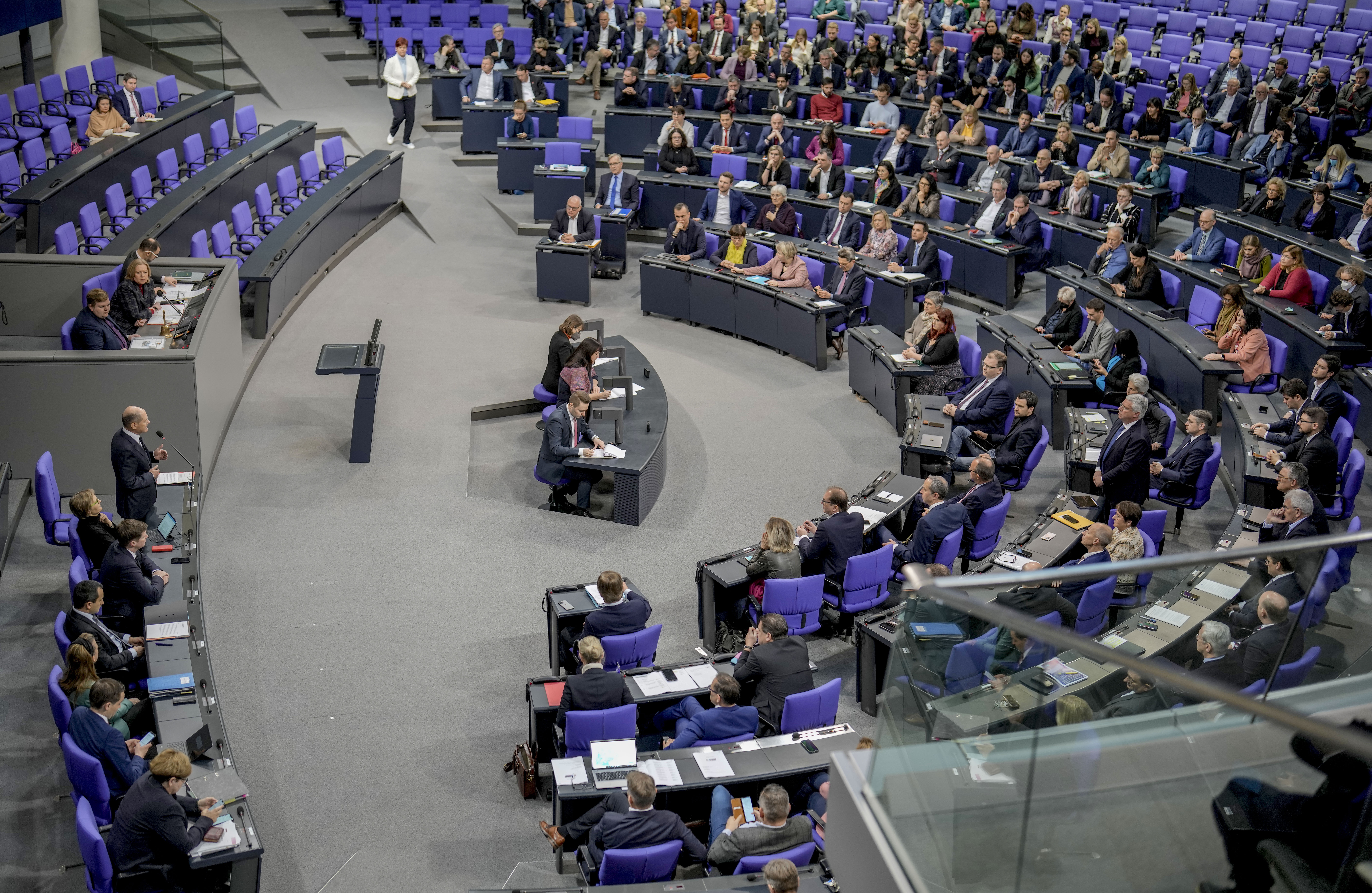 German Chancellor Olaf Scholz, left, speaks to thee lawmakers in the German parliament Bundestag in Berlin, Wednesday, Jan. 25, 2023. The German government has confirmed it will provide Ukraine with Leopard 2 battle tanks and approve requests by other countries to do the same. (Photo/Markus Schreiber)
German Chancellor Olaf Scholz, left, speaks to thee lawmakers in the German parliament Bundestag in Berlin, Wednesday, Jan. 25, 2023. The German government has confirmed it will provide Ukraine with Leopard 2 battle tanks and approve requests by other countries to do the same. (Photo/Markus Schreiber)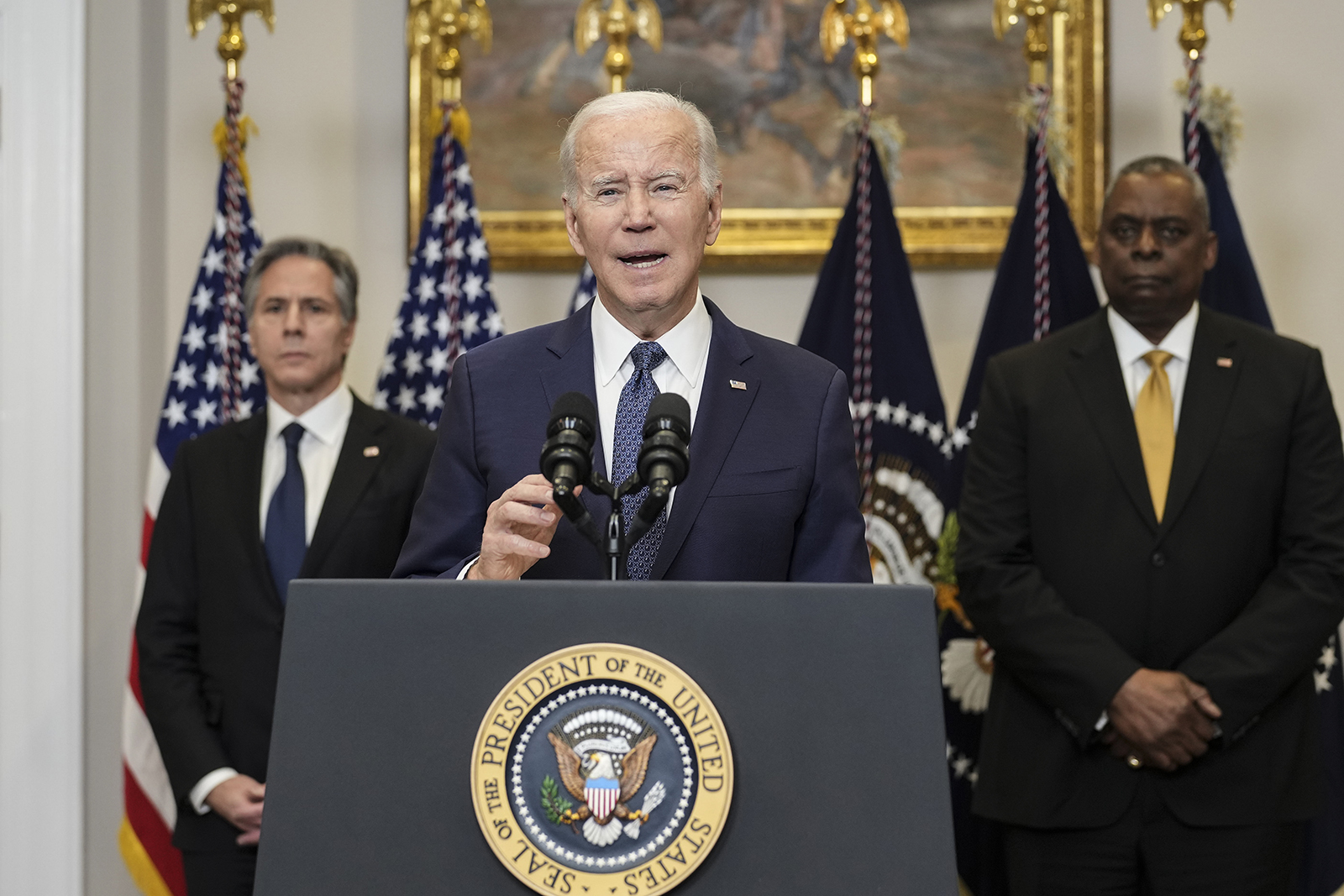 President Joe Biden, with Secretary of State Antony Blinken (left) and Defense Secretary Lloyd Austin at the White House on Wednesday, announces plans to send 31 M1 Abrams tanks to Ukraine, that with another 31 tanks from allies, will equip two Ukrainian tank battalions. (The New York Times/Doug Mills)
President Joe Biden, with Secretary of State Antony Blinken (left) and Defense Secretary Lloyd Austin at the White House on Wednesday, announces plans to send 31 M1 Abrams tanks to Ukraine, that with another 31 tanks from allies, will equip two Ukrainian tank battalions. (The New York Times/Doug Mills)